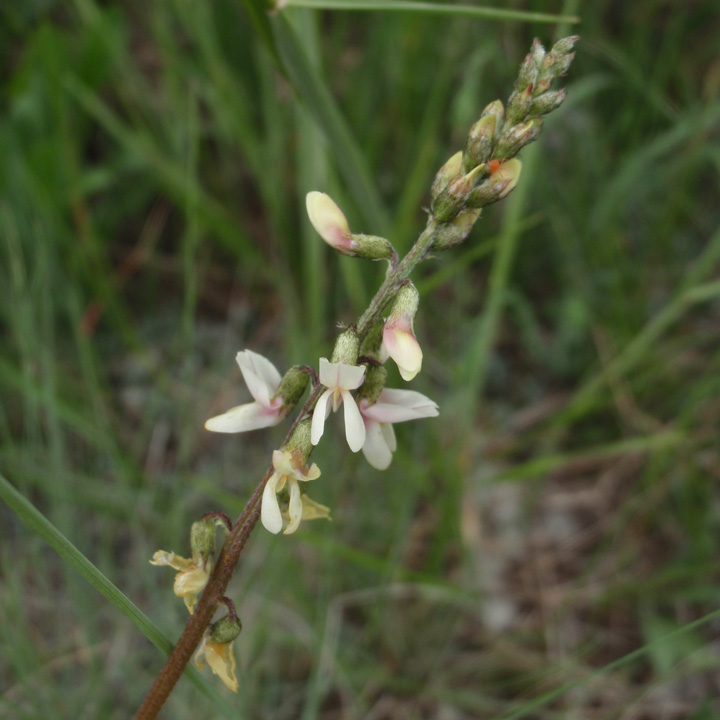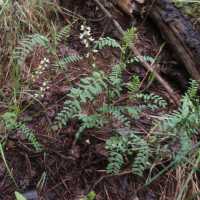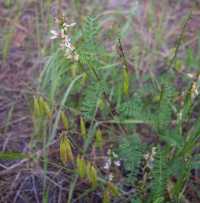Astragalus rusbyi
|
|
|
|
Family: Fabaceae
Rusby's Milk-Vetch, more...Rusby's milkvetch
|
General: Perennial; stems several, 15-35 cm long, erect and ascending, slender; herbage green, thinly strigose with basifixed hairs; caudex shortly branched. Leaves: Alternate, odd-pinnate, 3-8 cm long; leaflets 17-25, oval-oblong, oblanceolate, narrowly obovate, or ovate, 4- 11 mm long, glabrous above, sparsely strigose below, margins entire, apex obtuse, truncate, or shallowly notched; stipules connate, clasping the stem; blades petiolate, the upper ones usually more-or-less sessile. Flowers: Inflorescence an axillary raceme, loosely 4-10 flowered; peduncle 4-10 cm long, usually shorter than the leaf; calyx 6-12 mm long, glabrous to thinly strigose, the teeth 2-5 mm long, often bearing appressed hairs in the sinuses; corolla white, yellowish white, sometimes tinged with lavender; banner 11-23 mm long, the wings the same or slightly shorter; flowers May-July. Fruits: Legume, pendulous, linear-oblong or linear-obovoid, 1.3- 2.2 cm long, 3.2-4.1 mm in diameter, straight or obscurely curved, pale green, becoming straw colored, thinly strigose; legumes stipitate, the stipe 2.2-5 mm long. Ecology: Meadows or openings in ponderosa pine forests, thicket edges, aspen groves; 1600-2400 m (5400-8000 ft); endemic to Coconino County (near Flagstaff ) and possibly Yavapai County; southwestern U.S. Notes: The erect stature, narrow raceme of white flowers, and conspicuous, fused stipules aid in field identification of this species. Astragalus recurvus (recurved milkvetch) is very similar to A. rusbyi, but is distinguished by its low, spreading habit, the stems decumbent with ascending tips; leaves with 9-19 leaflets, these oblong-obovate, elliptic, or linear-oblong; racemes mostly 7-25 flowered, the corolla whitish, tinged with dull lilac; banner is 5- 8 mm long, with wings nearly as long or slightly longer; legumes are pendulous, linear-oblong or linear-elliptic, 1.3-2.5 cm long, strongly decurved, green, sometimes purplish tinged, finely strigose; legumes are sessile or nearly so, the stipe, if present, not longer than 0.7 mm. Its habitat includes openings in ponderosa pine forests, oak and pine woodlands, often in volcanic soils at 1500- 2300 m (5000-7500 ft). Astragalus egglestonii (Eggleston-s milkvetch) is slender but stiff with several stems, 20-55 cm tall, erect and strictly ascending; herbage appears glabrous but bears a few scattered hairs; leaves are 4-12 cm long, with mostly 21-29 leaflets, these oblong-oblanceolate or elliptic; racemes are 10-30 flowered, the corolla whitish to dull yellowish white; legumes are pendulous, linear-oblong or linear-oblanceolate, 1.5-3 cm long, straight or nearly so, green, glabrous. It commonly occurs in meadows and open pine woods in Apache County (White Mountains). Astragalus flexuosus (pliant milkvetch) is slender, with several stems, 15-60 cm long, decumbent with ascending tips; herbage is greenish or grayish, minutely strigose or villous; leaves are 2-9 cm long, with 11-25 leaflets, these linear, narrowly oblong, or oblong-oblanceolate, 3- 19 mm long, yellowish green, glabrous or less densely pubescent above than below; racemes are 10-30 flowered, corolla whitish to cream or bright pink-purple, the tips nearly always suffused with pale purple, the banner 7-11 mm long, with wings slightly shorter; legumes are pendulous or spreading, linear-oblong, linear- oblanceolate, to linear-elliptic, 1.1-2.4 cm long, green or mottled, strigose, seldom glabrous. It occurs in open habitats, fields, oak thickets, and pinyon-juniper woodlands, on sandy to gravelly soils at 1300-2300 m (4400-7400 ft). Astragalus straturensis (pine valley milkvetch) is a slender perennial, often forming low bushy clumps; stems are several to many, 15-30 cm long, decumbent and ascending; herbage is minutely strigose with basifixed hairs; leaves are 3.5-9.5 cm long with 11- 19 leaflets, these oblong or linear-oblong, 3-13 mm long, green and glabrous above, paler or gray-green below; racemes are 9-25 flowered, the corolla bright violet- purple, with whitish or sometimes yellowish wing tips, the banner 6-8.5 mm long, the wings slightly shorter; legumes are loosely pendulous, narrowly oblong- oblanceolate, 1-1.5 cm long, slightly curved or nearly straight, green, minutely strigose. It typically occurs on dry hillsides and ridges, often associated with pinyon-juniper woodlands, sometimes along the edges of oak thickets at 1500-2100 m (5000-7000 ft). Editor: Springer et al. 2008 |



